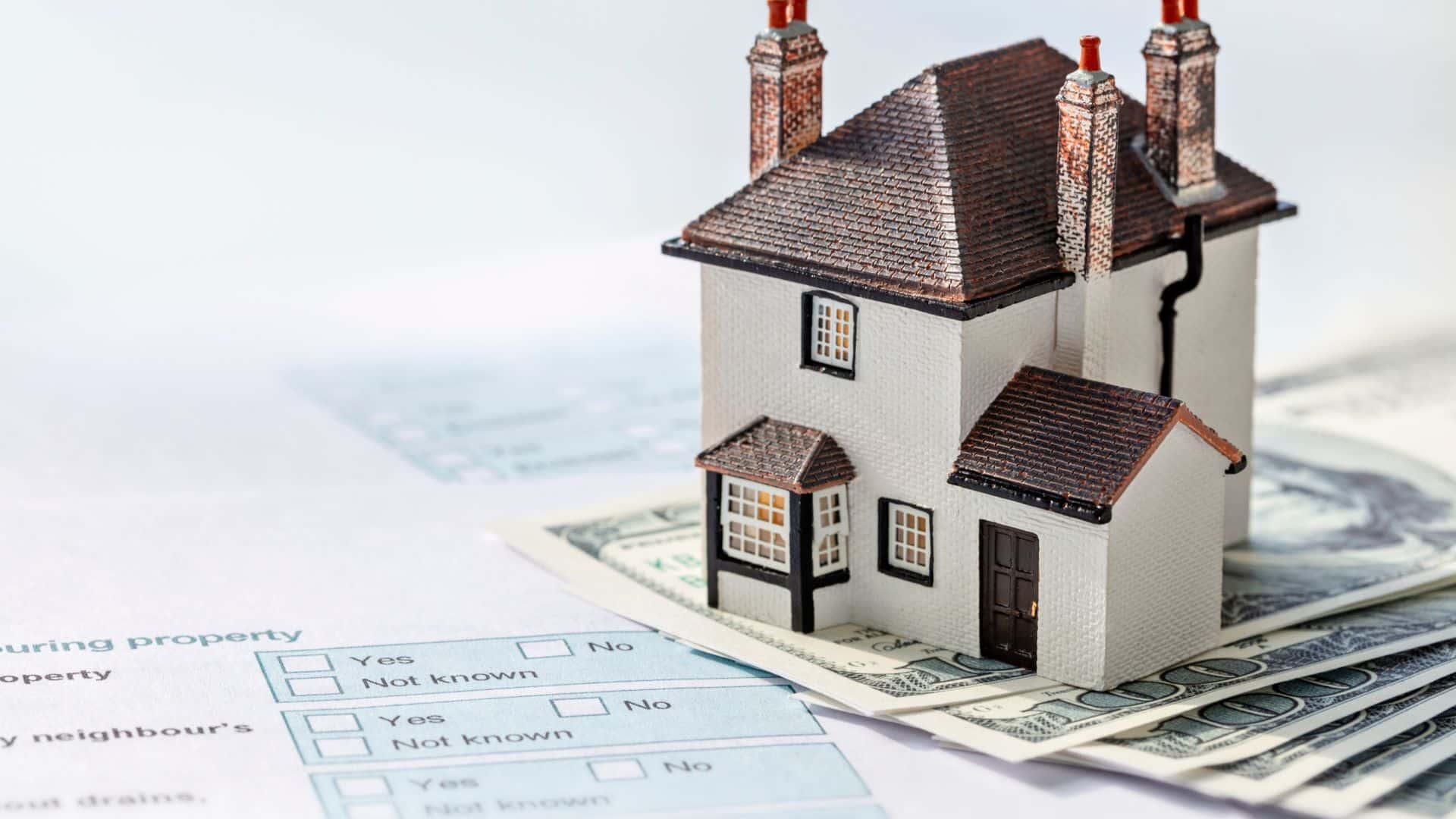When homeowners in Calgary and throughout Alberta fall behind on mortgage payments, they may face the foreclosure process. This legal procedure allows lenders to recover the outstanding mortgage balance by selling the property. In Alberta, lenders typically initiate foreclosure proceedings after several missed payments.
The Second Mortgage Store, based in Calgary, AB, Canada, and reachable at +1 403-827-6630, specializes in helping homeowners navigate these complex situations. Understanding the rights of both lenders and borrowers is crucial during this process. By taking prompt action, homeowners can often prevent foreclosure from advancing to later stages.
Key Takeaways
- Foreclosure proceedings in Alberta typically start after multiple missed mortgage payments.
- Lenders have the right to initiate foreclosure to recover outstanding mortgage balances.
- Homeowners have rights during the foreclosure process that they should be aware of.
- Prompt action can help prevent foreclosure from advancing.
- The Second Mortgage Store offers expertise in navigating foreclosure situations in Calgary.
What Triggers the Alberta Foreclosure Court Process
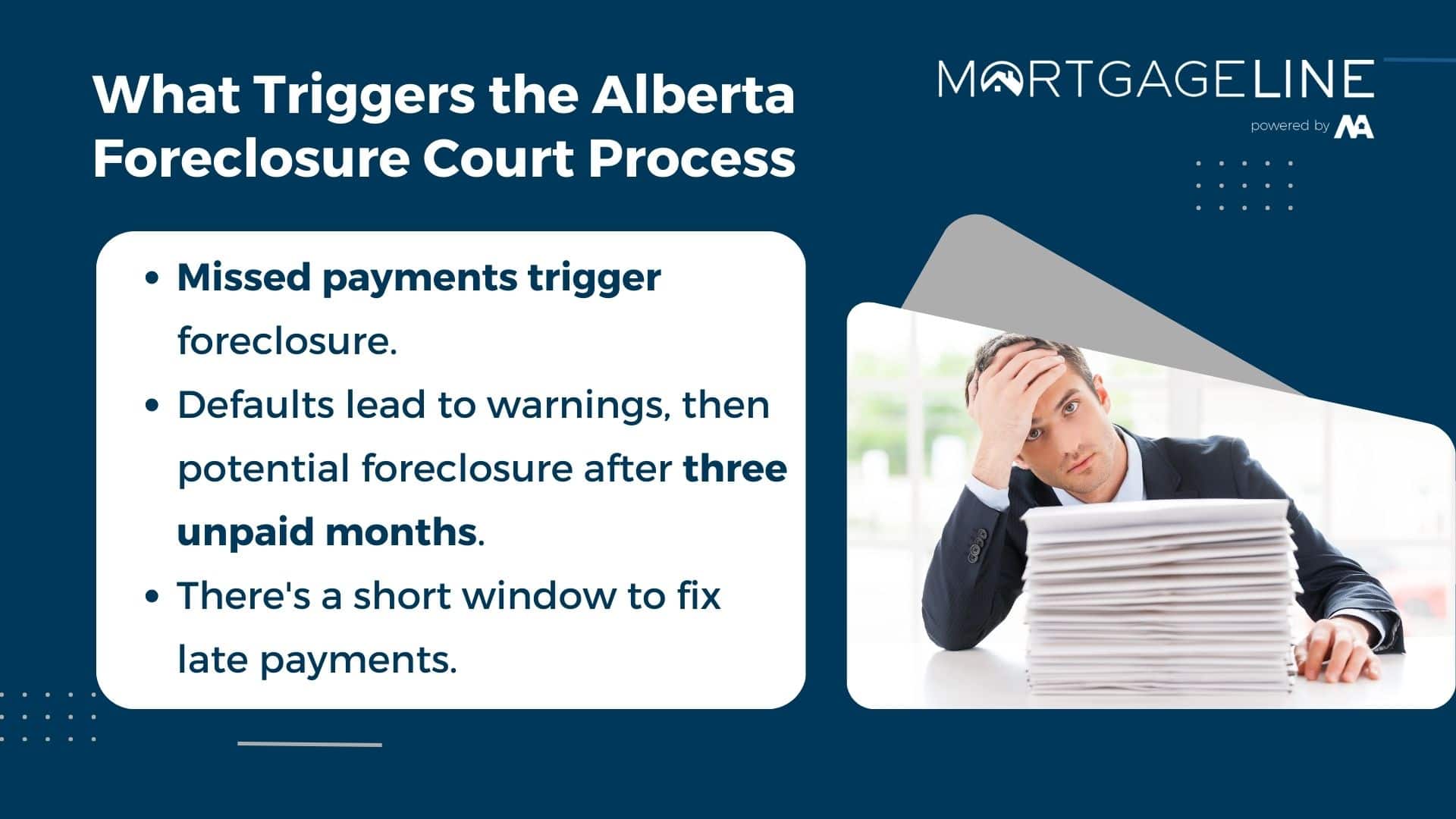
The Alberta foreclosure court process is triggered by a series of missed mortgage payments, which can be a daunting experience for homeowners. Understanding the timeline and steps involved can help borrowers navigate this challenging situation.
Common Types of Mortgage Defaults
Mortgage defaults in Alberta typically occur when homeowners fail to make payments as stipulated in their mortgage agreement. The most common type of default is the failure to make timely mortgage payments, leading to arrears. Lenders usually have specific policies in place for handling such defaults, which may include communication with the borrower to rectify the situation.
| Type of Default | Lender’s Initial Response |
|---|---|
| First Missed Payment | Courtesy reminder via phone call or written notice |
| Second Missed Payment | Formal demand letter outlining consequences of continued non-payment |
| Three Months of Non-Payment | Initiation of formal foreclosure proceedings |
Timeline After Missing Payments
After missing mortgage payments, homeowners in Alberta can expect a specific timeline of events to unfold. Initially, lenders may contact borrowers to remind them of the missed payment. If the situation is not rectified, lenders may send a formal demand letter after the second missed payment, followed by notices of arrears or foreclosure letters after three months of non-payment.
During this period, borrowers have a grace period, typically 35 days, to bring their mortgage current. The timeline may vary depending on the lender’s policies and the borrower’s response to initial notices. Proactive engagement with lenders can often lead to more favorable outcomes.
Step-by-Step Guide to the Alberta Foreclosure Court Process
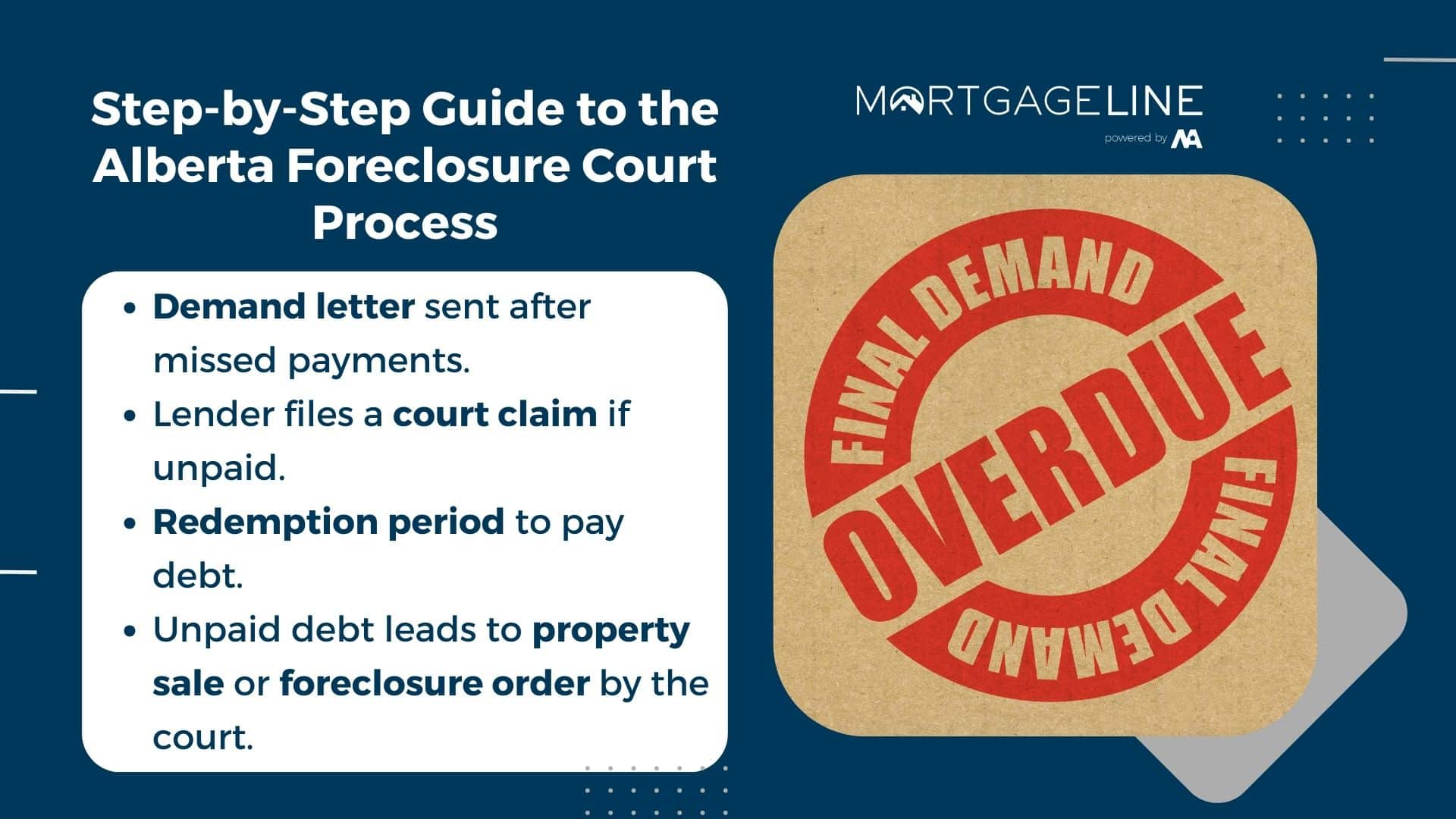
Understanding the Alberta foreclosure court process is crucial for homeowners facing financial difficulties. The process involves several key steps, from initial contact to the final sale of the property.
Initial Contact and Demand Letters
The foreclosure process begins when a lender sends a demand letter to the borrower, typically after three missed mortgage payments. This letter outlines the amount owed and provides a deadline for payment. If the borrower fails to comply, the lender may proceed with filing a Statement of Claim with the court.
Filing of Statement of Claim
The lender files a Statement of Claim with the court, which formally initiates the foreclosure process. The borrower is served with the claim and has a limited time to respond. If the borrower fails to respond, the court may grant a default judgment in favor of the lender.
The Redemption Period Explained
After the Statement of Claim is filed, a redemption period is established, during which the borrower can redeem the mortgage by paying off the outstanding debt. The length of this period varies depending on the court’s decision.
Court-Ordered Sale vs. Order for Foreclosure
Once the redemption period expires, the court may order a sale of the property or grant an order for foreclosure. In a court-ordered sale, the property is listed with a real estate agent, and the sale proceeds are used to pay off the debt. In contrast, an order for foreclosure transfers the property directly to the lender, potentially leading to a deficiency judgment if the debt is not fully satisfied.
As noted by a legal expert, “The court’s decision to grant an order for sale or foreclosure depends on various factors, including the property’s market value and the borrower’s financial situation.”
In most residential foreclosure cases in Alberta, lenders prefer to pursue a court-ordered sale rather than taking title to the property directly. This approach allows for a more transparent and fair process, as the court reviews and approves the sale.
Borrower Options When Facing Foreclosure in Alberta
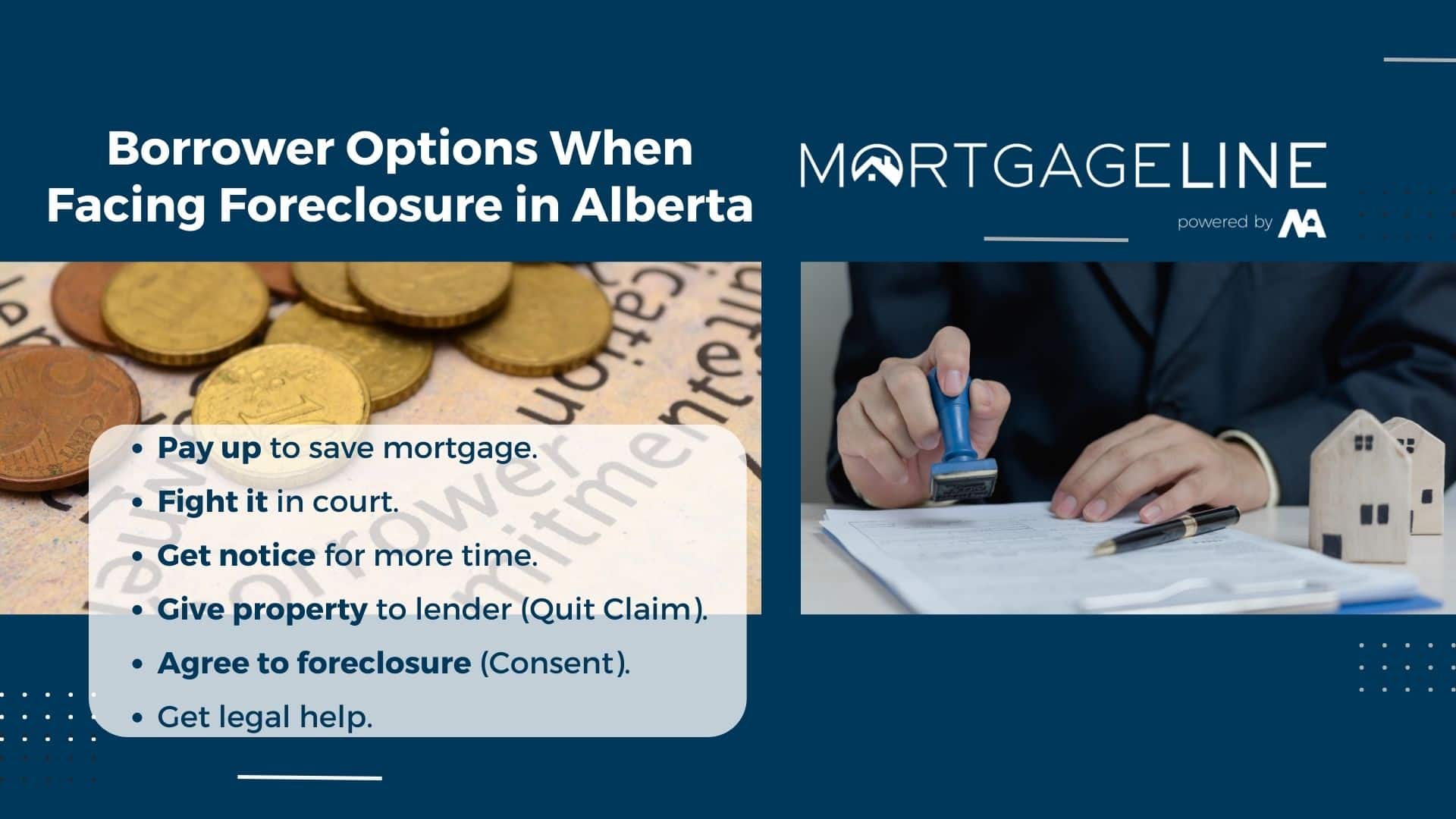
The foreclosure process in Alberta doesn’t necessarily mean borrowers are without options. When faced with the possibility of losing their property, borrowers can consider several alternatives to mitigate the impact of foreclosure.
Repaying Arrears and Reinstating the Mortgage
One viable option for borrowers is to repay the arrears and reinstate their mortgage. This involves paying off the missed payments, along with any associated fees, to bring the mortgage up to date. By doing so, borrowers can avoid the foreclosure process and continue with their original mortgage agreement.
Filing a Statement of Defense
Borrowers who believe the foreclosure action is unjustified or wish to contest the lender’s claim can file a Statement of Defense. This legal response allows borrowers to present their case in court, potentially halting or delaying the foreclosure process. It’s crucial for borrowers to seek legal advice when pursuing this option.
Demand of Notice and Its Benefits
A Demand of Notice is a legal request that requires the lender to notify the borrower before proceeding with the foreclosure sale. This can provide borrowers with additional time to explore alternatives or negotiate with the lender. By filing a Demand of Notice, borrowers can gain more control over the foreclosure timeline.
Quit Claim and Consenting to Foreclosure
In certain circumstances, borrowers may consider a quit claim or consenting to foreclosure. A quit claim involves transferring the property title directly to the lender, avoiding the full foreclosure process. Consenting to foreclosure acknowledges the lender’s right to foreclose but may allow for negotiated terms. Both options require careful consideration and legal advice to understand the implications and potential consequences.
Borrowers facing foreclosure in Alberta should be aware of their rights and the options available to them. Seeking legal advice is crucial in navigating the complexities of the foreclosure process and making informed decisions about their property and financial circumstances.
Financial and Legal Implications of Foreclosure
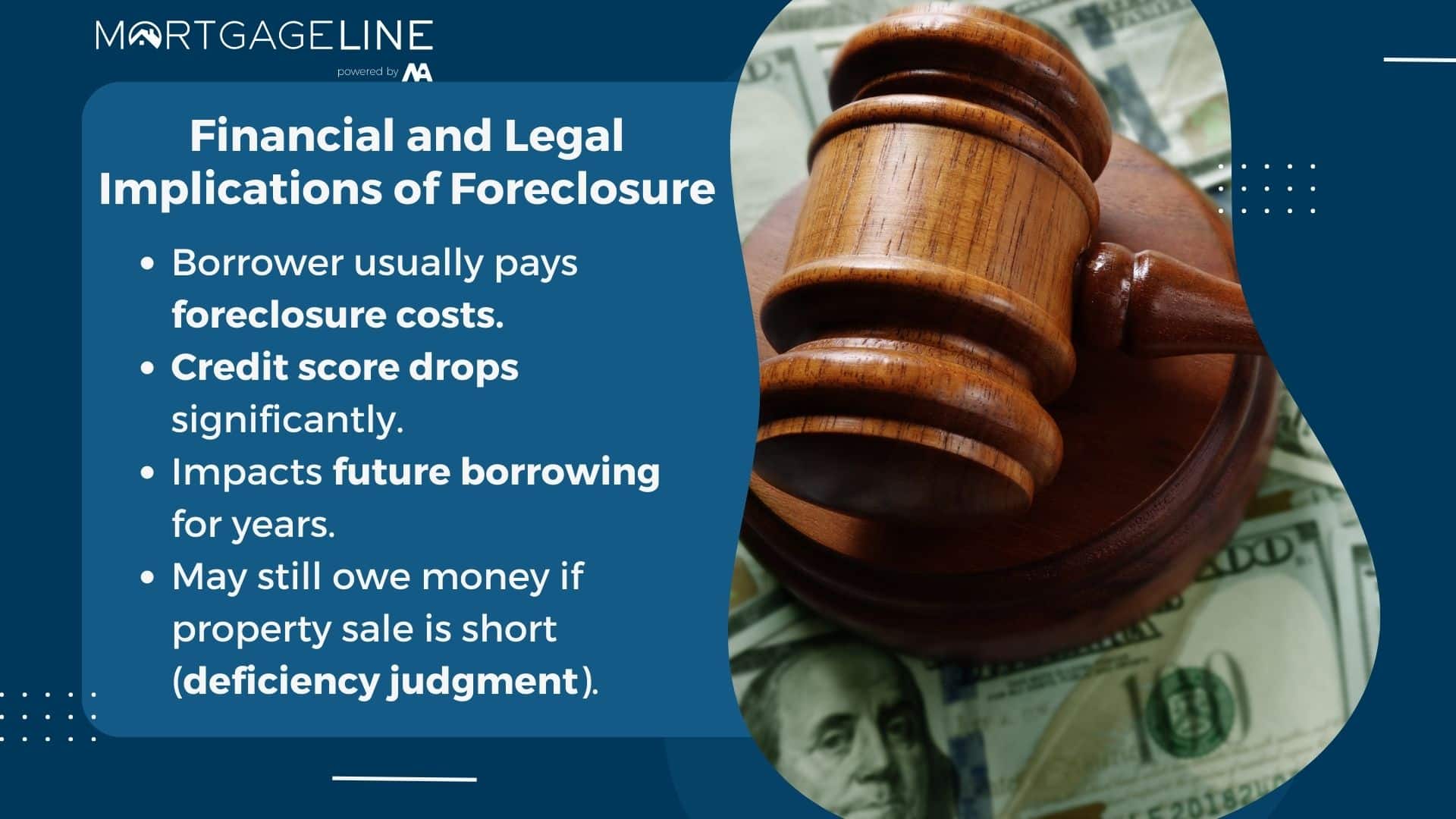
Understanding the financial and legal implications of foreclosure is crucial for borrowers in Alberta. Foreclosure can have far-reaching consequences, affecting not only one’s financial stability but also their credit score and future borrowing capabilities.
Who Pays for Foreclosure Costs
Foreclosure costs can be substantial, including legal fees, court costs, and other expenses associated with the foreclosure process. Typically, the borrower is responsible for these costs, although in some cases, the lender may absorb certain expenses. A breakdown of typical foreclosure costs is shown in the table below.
| Cost Category | Typical Amount |
|---|---|
| Legal Fees | $2,000 – $5,000 |
| Court Costs | $1,000 – $3,000 |
| Other Expenses | $1,000 – $2,000 |
Impact on Your Credit Score and Future Borrowing
Foreclosure can significantly impact one’s credit score, potentially lowering it by 200-300 points. This can limit future borrowing capabilities, as lenders view individuals with a history of foreclosure as higher-risk borrowers. As noted by a financial expert, “A foreclosure can remain on your credit report for up to seven years, making it challenging to secure new credit during that time.”
“A foreclosure is a significant negative event on a credit report, and its impact can be long-lasting.”
Potential for Deficiency Judgments
In Alberta, lenders may pursue a deficiency judgment against borrowers if the sale of the foreclosed property does not cover the outstanding mortgage debt. This can result in further financial strain, as borrowers may be required to pay the remaining balance. It is essential for borrowers to understand their obligations and potential risks when facing foreclosure.
Foreclosure Alternatives in Calgary
Facing foreclosure in Calgary doesn’t mean you’ve exhausted all your options. Homeowners have several alternatives that can help them regain financial stability and avoid the long-term consequences of foreclosure.
Working with Your Lender on Payment Arrangements
One viable alternative is to work directly with your lender to establish new payment arrangements. This can include temporary reductions in payments, extensions of the mortgage term, or even a temporary suspension of payments. Lenders often prefer these arrangements as they avoid the costs associated with foreclosure.
Selling Your Property Before Foreclosure
Selling your property before foreclosure proceedings begin is another option. This can help you avoid the negative impact of foreclosure on your credit score and financial reputation. It requires quick action and often the assistance of a real estate professional to facilitate a timely sale.
Seeking Professional Mortgage Assistance
Professional mortgage assistance can provide homeowners with expert guidance and solutions tailored to their specific circumstances. The Second Mortgage Store specializes in helping Calgary homeowners navigate foreclosure alternatives.
How The Second Mortgage Store Can Help
The Second Mortgage Store has a proven track record of assisting homeowners in Calgary. Their team can negotiate with lenders, find refinancing options, and develop customized solutions to help clients avoid foreclosure. By accessing equity through second mortgages or private financing, homeowners can resolve arrears or consolidate debt.
For a confidential consultation and to explore your options, contact The Second Mortgage Store at +1 403-827-6630 or visit them in Calgary, AB. Their expertise can help you navigate the challenges of foreclosure and find a path towards financial recovery.
Conclusion: Navigating the Foreclosure Process in Alberta
The foreclosure process in Alberta involves several legal steps that homeowners should be aware of to navigate effectively. Understanding the Alberta foreclosure court process is crucial for homeowners facing mortgage difficulties, as it allows them to make informed decisions about their property.
From initial demand letters through the statement of claim, redemption period, and eventual judicial sale or foreclosure order, each stage of the process presents opportunities for homeowners to take action. Homeowners have the right of redemption, the right to file a statement of defence, and the right to demand notice of proceedings.
Prompt action is key to achieving more favorable outcomes. Homeowners should explore all available options, including repaying arrears, working with lenders on payment arrangements, or selling their property before foreclosure. For personalized assistance with foreclosure situations in Calgary and throughout Alberta, contact The Second Mortgage Store at +1403-827-6630.



